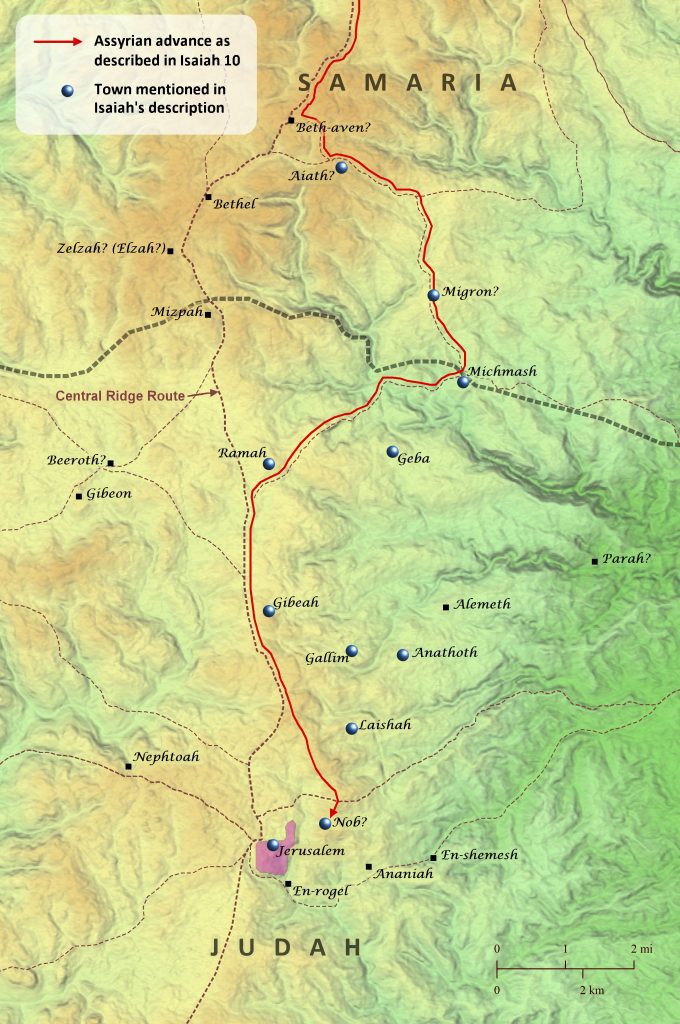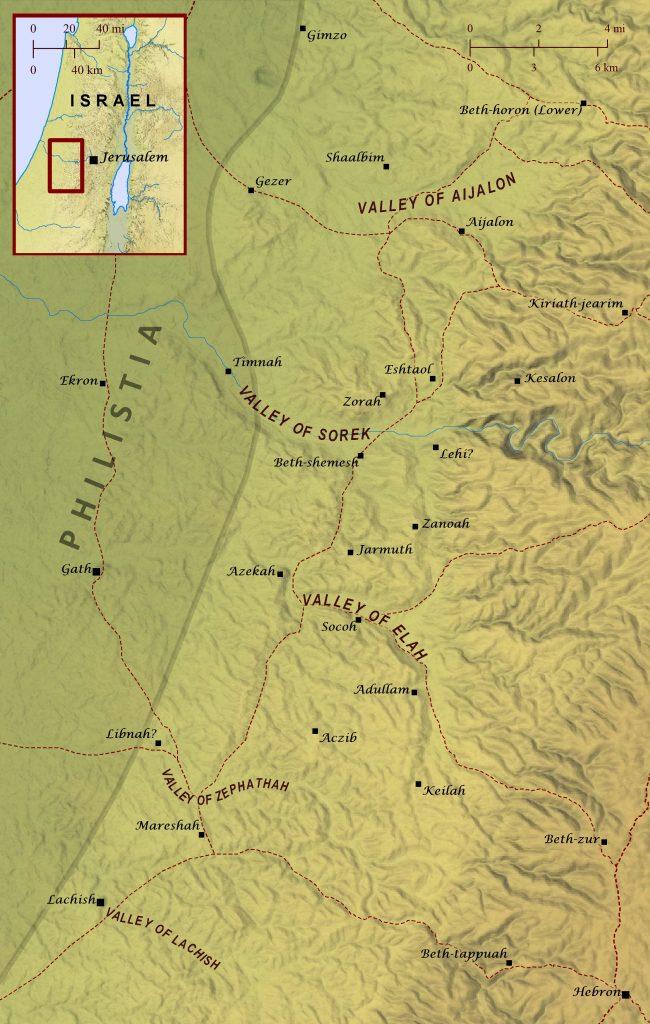The heartland of Midian was located immediately east of the Gulf of Aqaba, although the Midianites’ nomadic lifestyle often took them far beyond this region and even into the land of Israel. The Bible mentions the Midianites as early as Joseph’s time (Genesis 37:25-36) and as late as Isaiah’s time (Isaiah 60:6), but they may have existed in some form into the time of the New Testament as well, because the first century writers Josephus and Ptolemy mention places named Madian (likely also called Madiam and Madiana) and Modiana. Genesis notes that the Midianites were descended from Abraham through his wife Keturah (Genesis 25:1-6), but when Abraham’s great-grandson Joseph is sold to Midianite traders while at Dothan in Canaan, it appears that they are also referred to as Ishmaelites, suggesting that there must have been some categorical overlapping of these groups by the Israelites. Later Moses fled to Midian after killing an Egyptian, and he married Zipporah, a daughter of the Midianite priest named Reuel (Exodus 2). Later Reuel (also called Jethro) visited Moses and assisted him while he was with the Israelites at Mount Sinai (Exodus 18). When the Israelites were preparing to enter the Promised Land, however, the Midianites were involved in the plot to bring Balaam to curse to the Israelites (Numbers 22:4-7), and they led the Israelites into idolatry, leading Moses to curse them (Numbers 25). The Israelites later fought against the Midianites and defeated them (Numbers 31). During the time of the Judges, Midianites regularly raided places in Israel such as the Jezreel Valley (Judges 6:1-6), and the Lord raised up Gideon to defeat them. Centuries later Isaiah foretold of a time when the wealth of the nations, including Midian with its young camels, would be brought to Israel (Isaiah 6:1-7). Primarily because of Moses’ interactions with the Midianite Reuel, various mountain peaks within the land of Midian have been offered as possible locations of Mount Sinai, although the Bible specifically notes that Reuel (or Jethro) left Mount Sinai to return to his own land (Exodus 18:27; Numbers 10:30), suggesting that Mount Sinai was not located in Midian.

Assyria Advances on Jerusalem
Isaiah 10:24-34
Like the climax of a nail-biting thriller, Isaiah 10:24-34 traces the movements of an overwhelming force of Assyrians closing in on the city of Jerusalem, but just when all seems lost and the enemy is shaking his fist over the city, the Lord delivers his people. It is not clear if this story is only happening in Isaiah’s imagination or if Isaiah is recounting an actual historical event, such as Sennacherib’s invasion of Judah in 701 B.C. Either way, his point is clear: God’s people should trust in his sure salvation and not fear Assyria’s might. Earlier in the same chapter Isaiah reiterates the Assyrians’ boast of the cities that have already fallen to their power (verses 8-11), including Samaria, so this story must be set after Samaria’s fall in 722 B.C. The Assyrians begin their attack by traveling south along the Central Ridge Route, the primary north-south artery running through the central hill country, and then they turn off at Bethel to cross the pass at Michmash, perhaps to avoid the fortifications at Mizpah (see 1 Kings 15:22). Then they rejoin the main route at Ramah. Isaiah echoes the terror facing each of the towns along the Assyrians’ path, culminating with the Assyrians shaking their fist over Jerusalem from Nob, likely on the summit of the Mount of Olives. Before the enemy can take the city, however, the Lord cuts the Assyrians down and saves his people.

Zerah the Cushite
2 Chronicles 14
The book of 2 Chronicles contains the sole mention of an otherwise unknown battle between King Asa of Judah and Zerah the Cushite around 895 B.C. Prior to his description of the battle, the Chronicler notes that Asa had undertaken a campaign to fortify many of the towns throughout Judah, since the land was at peace and afforded them the means to do so. Apparently these efforts raised concerns among the Cushite peoples who dwelt along the western coast of Arabia (see Genesis 10:6-7), who likely feared that Asa was trying to tighten his control over important international trade routes that passed through southern Judah. The Arabian Cushites were well known for their gold, incense, and precious stones (1 Kings 9:28; 10:10-11; 22:48; 1 Chronicles 29:4; 2 Chronicles 8:18; 9:1-10; Job 22:24; 28:16; Psalm 45:9; Isaiah 13:12; 60:6; Jeremiah 6:20; Ezekiel 27:22), which they transported along the Incense Route and other roads to reach eager markets in the coastal cities of Philistia. So a Cushite named Zerah gathered a massive army and met Asa in battle at the Valley of Zephathah just north of Mareshah (see map of the Shephelah). During the battle the Lord struck down the Cushites, and they fled in the direction of Gerar, which may have been where the Cushites had camped in preparation for battle. Asa’s forces pursued them to Gerar and destroyed them completely, carrying off a great deal of plunder. Asa’s troops then destroyed and looted all the villages surrounding Gerar, which had likely hosted some of Zerah’s troops as well.

⤓ download hi-res file 🔍 see in TimeGlider
Earthquakes in the Bible
Throughout much of the ancient Near East earthquakes were at the same time familiar yet terrifying, and the great power demonstrated by them was often associated with God himself. While the most intense seismic activity of the region typically occurs far north of Israel around Pergamum, Ephesus, Melidu, and Tushpa, the land of Israel experiences earthquakes from time to time as well due to its position at the northern extreme of a major fault line running all the way down the Red Sea and into East Africa. The first mention of earthquakes in the Bible might be found in the story of the destruction of the cities of the plain, where it describes phenomena that could be explained as the result of an earthquake that caused subterranean hydrocarbons to explode (Genesis 19:24). Earthquakes also accompanied the giving of the Law at Mount Sinai and the subsequent wanderings of the Israelites in the desert (Exodus 19:18; Numbers 16:31-32; Judges 5:4; Psalm 68:8; Hebrews 12:26). Hundreds of years later the prophet Elijah journeyed to Mount Sinai and witnessed an earthquake as he waited for the Lord to pass by (1 Kings 19:11-12). During the reign of Uzziah of Judah in the eighth century B.C., an earthquake struck the land that was so severe that the prophet Amos dated his oracles by it (Amos 1:1), and over two hundred years later the prophet Zechariah foretold of a coming earthquake that would cause people to flee like they did when they fled from the earthquake in Uzziah’s time (Zechariah 14:5). In several other passages of the Old Testament earthquakes are a common response of the earth to the Lord (2 Samuel 22:8; Psalm 18:7; Isaiah 6:4; 13:13; Nahum 1:5; Habakkuk 3:3-6; Haggai 2:6), and Psalm 46:1-2 describes earthquakes leveling the mountains in order to portray complete insecurity in earthly things. Centuries later Jesus’ crucifixion was accompanied by earthquakes (Matthew 27:54; 28:2). The book of Acts also recounts how an earthquake struck Philippi while Paul and Silas were in jail there, and it was so violent that it broke open the doors and loosed the chains of the prisoners (Acts 16:25-28). Earthquakes are also frequently included in descriptions of things to come in the last days (Matthew 24:7; Mark 13:8; Luke 21:11; Revelation 6:12; 11:13; 16:18).

The Shephelah
The Shephelah, meaning “lowlands,” was a band of gentle hills lying between the coastal plain and the hill country of Israel, and it was covered with sycamore fig trees and olive trees (1 Kings 10:27; 1 Chronicles 1:15; 9:27; 27:28). This pastoral description of the region paints a deceptively peaceful picture, however, for the various valleys that cut through this region from west to east offered invading armies quick access to the heartland and key cities of Israel, making the Shephelah a very strategic stretch of land. Because of this, several important towns kept close watch over its key access points, including Aijalon, Beth-shemesh, Azekah, Libnah, Mareshah, and Lachish. From the very beginning of Israel’s conquest of the land, the valleys of the Shephelah were the location of pivotal battles, beginning with Joshua’s defeat of the Amorites at Aijalon while the sun stood still (Joshua 10:10-14; see “The Conquest of Canaan: The Southern Campaign” map). The Shephelah continued to serve as a buffer between the Philistines and the Israelites from the time of the Judges through the time of the Divided Monarchy. The Valley of Sorek was home to the judge Samson, so it is no surprise that he had several hostile encounters with the Philistines there (Judges 13-16; see “Samson’s Exploits” map). This same valley is also where the Philistines sent the Ark of the Covenant back to Israel after it afflicted them with tumors (1 Samuel 6:1-7:2; see “The Ark of the Covenant Is Captured and Returned” map). Later, young David slew Goliath in the Valley of Elah and sent the Philistines into a panic (1 Samuel 17; see “The Battle at Elah” map), and he also saved the people of Keilah from the Philistines in this valley while on the run from Saul (1 Samuel 23:1-5; see “David Flees from Saul” map). Later Jehoash of Israel defeated Amaziah of Judah at Beth-shemesh (2 Kings 14:11-14), and Asa defeated a massive army of Cushites at the Valley of Zephathah (2 Chronicles 14:9-15; see “Zerah the Cushite” map). During the final days of the northern kingdom of Israel, the Philistines captured several towns within the Shephelah as part of what was likely an effort to compel Judah to join an anti-Assyrian alliance (2 Kings 16-17; 2 Chronicles 28; Isaiah 7-8; see “The Final Days of the Northern Kingdom of Israel” map). After Israel had fallen to the Assyrians, king Sennacherib of Assyria attacked Lachish and Libnah to bring Hezekiah firmly under Assyria’s yoke (2 Kings 18:13-17; 19:8; 2 Chronicles 32:1-23; see “Sennacherib Attacks Judah” map). Years later when King Zedekiah rebelled against the rule of the Babylonians, they came and attacked every fortified city of Judah. Lachish and Azekah in the Shephelah were among the last cities to fall to the Babylonians (Jeremiah 34:1-7; see “Nebuchadnezzar’s Final Campaign against Judah” map). Finally, over four hundred years later Judas Maccabeus launched a surprise attack against Seleucid forces just west of Aijalon (1 Maccabees 3:38–4:25; 2 Maccabees 8:8–8:36).

